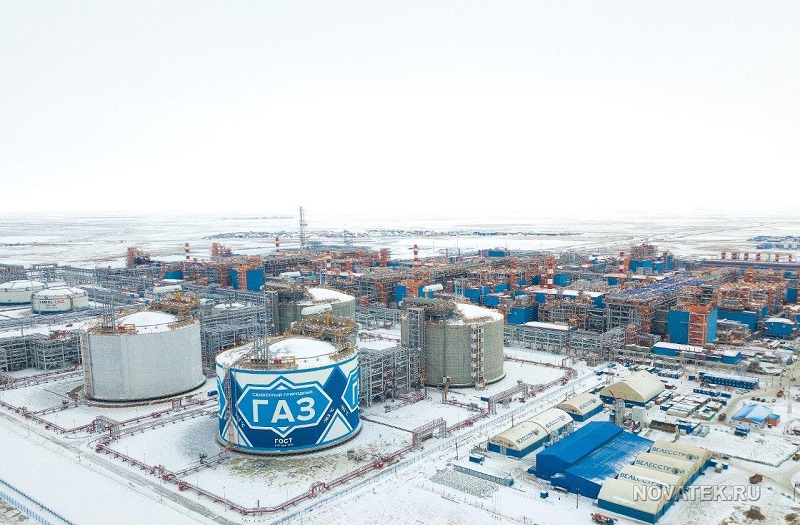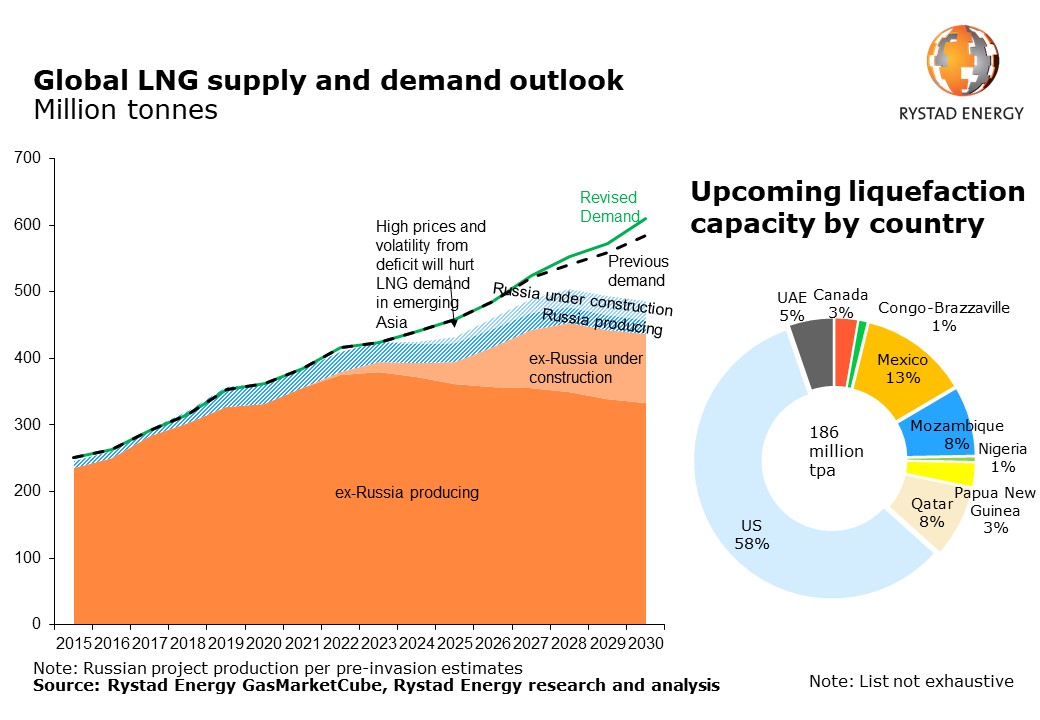Report: LNG Supply Crisis Will Make Landfall in Winter 2022
A liquified natural gas (LNG) crisis is brewing for European countries dealing with energy insecurity in the wake of Russia’s invasion of Ukraine, as demand will outstrip supply by the end of this year, according to a new report from Rystad Energy.
Although soaring demand has spurred the greatest rush of new LNG projects worldwide in more than a decade, construction timelines mean material relief is unlikely only after 2024.
Global LNG demand is expected to hit 436 million tonnes in 2022, outpacing the available supply of just 410 million tonnes. A perfect winter storm may be forming for Europe as the continent seeks to limit Russian gas flows. The supply imbalance and high prices will set the scene for the most bullish environment for LNG projects in more than a decade, although supply from these projects will only arrive and provide relief from after 2024
The European Union’s REPowerEU plan has set an ambitious target to reduce dependence on Russian gas by 66% within this year – an aim that will clash with the EU’s goal of replenishing gas storage to 80% of capacity by 1 November. By shunning Russian gas, Europe has destabilized the entire global LNG market that began the year with a precarious balance after a tumultuous 2021. The decision to sharply reduce reliance on Russian gas and LNG from current levels of between 30-40% will transform the global LNG market, resulting in a steep increase in energy-security based European LNG demand that current and under-development projects will not be able to supply.
Russia last year sent 155 billion cubic meters (Bcm) of gas to Europe, providing more than 31% of the region’s gas supply. Replacing a significant portion of this will be exceedingly difficult, with far-reaching consequences for Europe’s population, economy, and for the role of gas in the region’s energy transition. This will also likely create a boom for LNG producers elsewhere of a scale and duration not seen in over a decade.
“There simply is not enough LNG around to meet demand. In the short term this will make for a hard winter in Europe. For producers, it suggests the next LNG boom is here, but it will arrive too late to meet the sharp spike in demand. The stage is set for a sustained supply deficit, high prices, extreme volatility, bullish markets, and heightened LNG geopolitics,” Kaushal Ramesh, senior analyst for Gas and LNG at Rystad Energy, said.
The expected reduction in Russian gas for Europe in 2022 is 37 Bcm, rising to more than 100 Bcm by 2030. As a result, Europe’s gas consumption likely peaked in 2019 and will now decline steadily through to 2030. Gas and LNG is therefore set to play a reduced role in Europe’s energy mix, providing further impetus for renewables and potentially a greater role for nuclear and coal.
Europe was in fact on course to increase Russian imports of gas and LNG to over 40% of its supply by 2030, if the now stalled Nord Stream 2 pipeline had been approved. This will instead drop to around 20% by 2030 as current contracts are not renewed. To facilitate additional LNG imports, a slew of regasification terminals has been planned across Europe — some new and some reactivated from deep slumber.
If Russian flows were to stop tomorrow, the gas currently in storage (about 35% full) would likely run out before the end of the year, leaving Europe exposed to a brutal winter. Under this scenario, in the absence of joint buying arrangements and countries competing for limited molecules, the TTF gas price could climb to more than $100 per million British thermal units (MMBtu), resulting in industrial curtailments and widespread fuel switching in the power sector. We have already seen curtailments to fertilizer, steel and paper manufacturers in Europe, underscoring the economic pain that awaits. In an extreme scenario of a severely cold winter, not even the residential sector would be safe.
More than LNG 20 projects with a combined capacity of over 180 million tonnes per annum (MMtpa) have reported some development progress recently. To be certain of LNG supply in 2030, the market will need more than 150 MMtpa of production from the 186 MMtpa planned, which means more than 80% of the project pipeline must be realized.
US projects are in pole position – some of which have been dormant waiting for demand to rise, and have now been given new life. Projects such as Energy Transfer’s Lake Charles and NextDecade’s Rio Grande that were previously on ice have reported 9.45 MMtpa worth of deals after the invasion, including an about-face deal by French player Engie, which pulled out of negotiations with NextDecade in November 2020 but recently closed a 1.75 MMtpa deal with the same project.
However, the project pipeline globally remains far from able to rescue the market. It includes the 15 MMtpa Rovuma Area 4 LNG project, to be located adjacent to TotalEnergies’ Area 1 LNG in the currently at-risk Palma region of Mozambique. We expect little to no progress on this project until TotalEnergies resumes construction.
Mexico is also well-positioned for Asian exports due to geographical proximity and non-dependence on transit through the Panama Canal, and appears to be gaining momentum among Asian buyers. At the same time, higher prices will slow Asian LNG demand growth in the medium term, which means the continent will remain dependent on fuel oil and coal. In some scenarios, Asian LNG demand may be permanently dented, and deployment of renewables accelerated.
Related News
Related News

- Enbridge Plans 86-Mile Pipeline Expansion, Bringing 850 Workers to Northern B.C.
- Intensity, Rainbow Energy to Build 344-Mile Gas Pipeline Across North Dakota
- U.S. Moves to Block Enterprise Products’ Exports to China Over Security Risk
- Strike Pioneers First-of-Its-Kind Pipe-in-Pipe Installation on Gulf Coast with Enbridge
- 208-Mile Mississippi-to-Alabama Gas Pipeline Moves Into FERC Review
- U.S. Pipeline Expansion to Add 99 Bcf/d, Mostly for LNG Export, Report Finds
- A Systematic Approach To Ensuring Pipeline Integrity
- 275-Mile Texas-to-Oklahoma Gas Pipeline Enters Open Season
- LNG Canada Start-Up Fails to Lift Gas Prices Amid Supply Glut
- Strike Pioneers First-of-Its-Kind Pipe-in-Pipe Installation on Gulf Coast with Enbridge






Comments